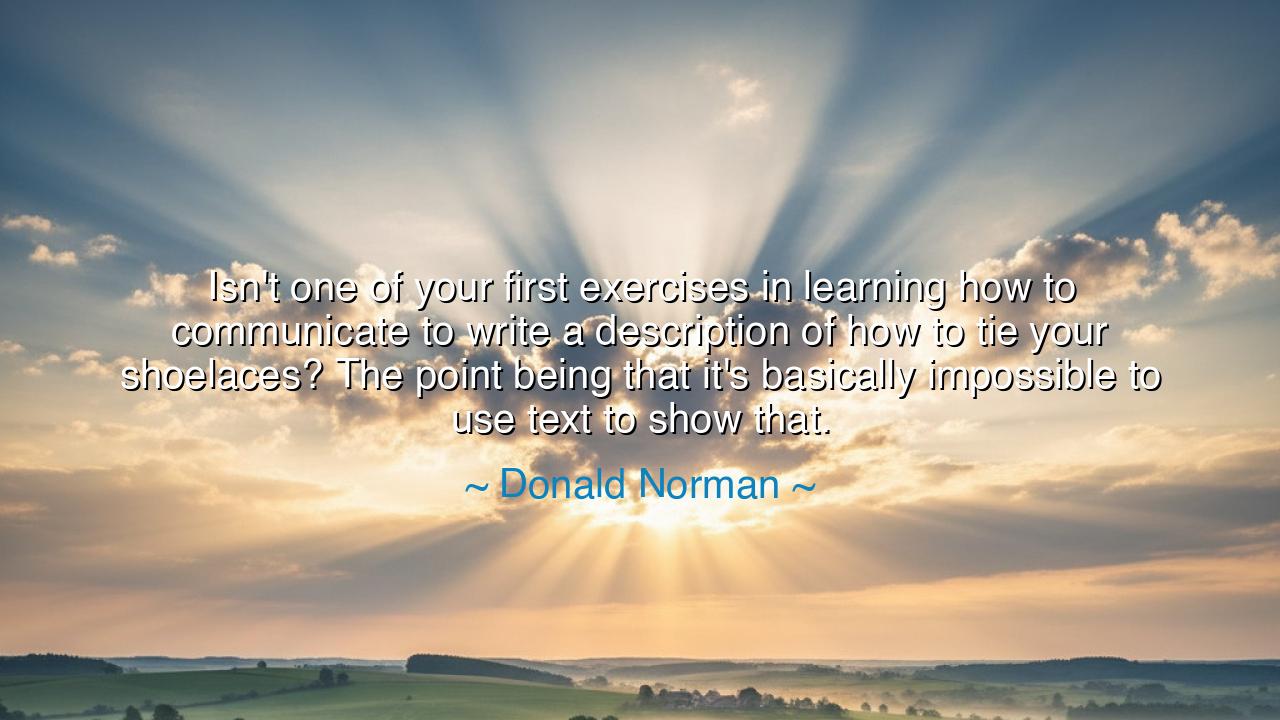
Isn't one of your first exercises in learning how to communicate
Isn't one of your first exercises in learning how to communicate to write a description of how to tie your shoelaces? The point being that it's basically impossible to use text to show that.






Donald Norman once observed with clarity both playful and profound: “Isn’t one of your first exercises in learning how to communicate to write a description of how to tie your shoelaces? The point being that it’s basically impossible to use text to show that.” At first these words may stir laughter, for who has not fumbled with explaining such a simple task? Yet behind the humor lies a truth that echoes through ages: that the limits of words are real, that not all things can be spoken or written, and that to communicate is not merely to command language, but to understand the gulf between symbol and experience.
The act of tying shoelaces is a simple motion of hands, a ritual so common that children master it in early years. Yet when one is asked to put it into words, the simplicity collapses. Loops, crossings, pulls—suddenly the task seems labyrinthine. Norman reveals this paradox to remind us that text alone, no matter how elaborate, struggles to capture the essence of action. It is the same in all things: to describe the taste of fruit is not to eat it; to narrate the sound of a melody is not to hear it. Thus, communication has its boundaries, and wisdom lies in knowing them.
The ancients knew this truth well. Laozi, the sage of the Tao, began his teaching by declaring: “The Tao that can be spoken is not the eternal Tao.” In other words, the greatest realities cannot be captured in words. They can only be lived, practiced, experienced. Norman’s image of shoelaces is a modern echo of this ancient insight: that even the simplest of motions resists full translation into symbols. If even this is so, how much more so the mysteries of love, beauty, and truth?
Consider the example of the Japanese martial arts. A master may write volumes on how to hold a sword or move the body, but no scroll will transform a novice into a warrior. Only through demonstration, practice, and repetition do the movements sink into muscle and spirit. The master’s gestures teach what text cannot. In the same way, tying a knot, carving wood, or even offering kindness—all are best shown in the flesh, not confined to the prison of words.
Yet let us not despise words because they are limited. Rather, let us use them wisely. Words are bridges, not the shores themselves. They point toward truth, even if they do not embody it. Norman’s point is not to diminish writing, but to remind us that true communication requires more: gesture, tone, demonstration, presence. To teach is not only to speak, but to show. To love is not only to declare, but to act. To inspire is not only to write, but to live.
The lesson, then, is clear: never mistake the description for the thing itself. Read the words, but go beyond them. Study the text, but seek the experience. If you are a teacher, remember that your students will not learn only by hearing, but by doing. If you are a seeker of wisdom, do not be content with reading of virtue—practice it, embody it, until it becomes as natural as tying your shoelaces.
Thus the path is revealed: combine word with deed, symbol with action, writing with living. Take Norman’s teaching to heart and do not let your life be only a page of instructions, dry and incomplete. Let it be an example, a demonstration, a living guide. For words alone may falter, but when joined with action, they shine with power.
In the end, to communicate is not only to speak but to show, not only to write but to live. And so, let us tie our shoelaces not only with our hands, but with our lives—binding together word and action, thought and deed—so that those who follow us may not only hear what we teach, but see it, touch it, and walk in it themselves.






AAdministratorAdministrator
Welcome, honored guests. Please leave a comment, we will respond soon